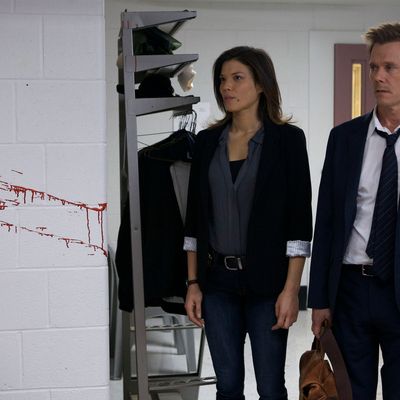
Is the serial-killer genre played out? You might think so from watching tonight’s debut of The Following (Fox, Mondays, 9 p.m.). It slots the usual clichés into place: a genius serial killer named Joe Carroll (James Purefoy) who quotes classic literature; a disgraced, depressed, alcoholic ex-FBI profiler named Ryan Hardy (Kevin Bacon) who’s re-called to service to catch Carroll; gory murders reconfigured in the killer’s mind as art; kidnappings and disfigurements, lairs and labs, choppers fluttering toward Quantico. Within fifteen minutes, I scribbled “Thomas Harris has a lot to answer for” on my notepad.
There are exceptions to rules, though, and I was pleasantly surprised when The Following, created by Kevin Williamson (of Scream, Dawson’s Creek, and The Vampire Diaries fame) turned out to be one of them. If you can stick with the show through the end of its second episode, you’ll see what I’m getting at. Aside from the notion of Purefoy’s character, former literature professor Joe Carroll, becoming a cult figure in prison and growing a secret army via the Internet, nothing in this pilot promises how fascinating the show will ultimately become, and unfortunately, the show is more efficient than truly good. Superficially, The Following is a typical network suspense/violence serial, distressingly comfortable with bum dialogue, inordinately pleased with its shallow allusions to Edgar Allan Poe (“’Nevermore’! ‘The Raven’! Poe is symbolizing the finality of death!”), and cinematically impoverished to boot. The first four episodes contain no aesthetically pleasing shots or sequences, just tedious coverage of talk and action, and too many of its “shocking” moments are dependent on visual/aural shortcuts: for instance, pushing the camera up close to a screaming victim’s knife wound (this is one of the most violent shows in network TV history), or scoring a chance, harmless collision between two FBI agents in a dark hall with a synthesized “BOOM!” Nevertheless, The Following fascinates, thanks to soulful lead performances by Bacon and Justified’s Natalie Zea (as Carroll’s ex-wife) and the nervy way it develops and sustains its central flourish.
The Following seems less of a straight-up Thomas Harris rip-off than a metaphoric working-through of the immediate post-9/11 era, when American minds were fogged by trauma and paranoia and susceptible to fear-mongering and magical thinking. Purefoy’s character is bin Laden, or what Americans imagine bin Laden to have been: a brilliant, charismatic monster with a near-godlike ability to twist individuals’ psychologies and turn them into extensions (or clones) of himself. The followers that do Carroll’s bidding — committing murders and kidnappings, settling personal scores, and adding “chapters” to the nonfiction narrative he’s composing in real time — feel like homegrown versions of the terrorist sleeper agents everyone was afraid would awaken after living peaceably among us for years. Certain lines seem to allude to modern terrorism’s Amway-like strategy of franchising ideologically driven violence. Some of Carroll’s minions act directly on his wishes, while others appear to have contacted him once or twice, absorbed his “philosophy,” and then gone out into the world to commit Carroll-like acts for personal satisfaction as well as homage. At one point, the hero describes a Carroll groupie’s mass murder as an attempt to “[follow] in the footsteps of his hero, the ceremonial work of an acolyte.” “Maybe he’s not just a bad man,” another acolyte says of Carroll. “Maybe we just don’t understand him.”
Once you become attuned to the show’s anti-logic, the mix of gnawing dread and random mayhem might trigger the gloomy adrenaline rush of the 2001–2004 period. Hijackings, collapsing skyscrapers, subway explosions, shoe bombers, anthrax attacks, terror alerts, weapons of mass destruction: The Following evokes an alternate-world version of that horrendous time. Watch the skies. Sleep with the lights on. Trust no one. Those co-workers or next-door neighbors or smiling security guards that you deal with each day could be in cahoots with an ice-veined genius-madman. Portions of the first few episodes reminded me less of The Silence of the Lambs or Se7en than a zombie or body-snatchers picture, one in which every character but the lead could secretly be, or potentially become, a monster. Parts of The Following feel like 24 with serial killers instead of terrorists. It’s an apocalypse story as long-form nightmare. The whole world is losing its mind.


